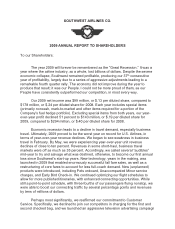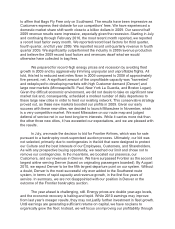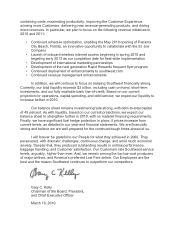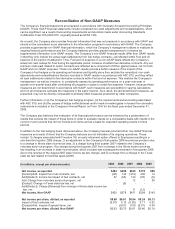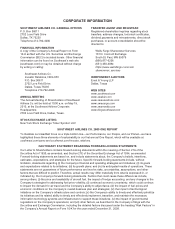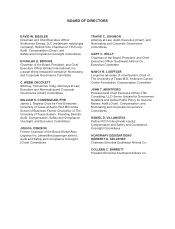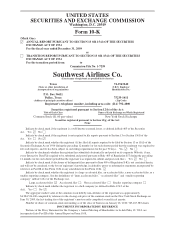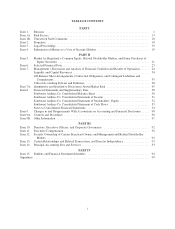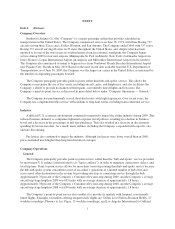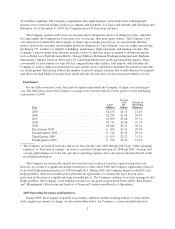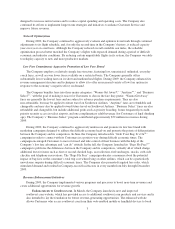Southwest Airlines 2009 Annual Report Download - page 9
Download and view the complete annual report
Please find page 9 of the 2009 Southwest Airlines annual report below. You can navigate through the pages in the report by either clicking on the pages listed below, or by using the keyword search tool below to find specific information within the annual report.PART I
Item 1. Business
Company Overview
Southwest Airlines Co. (the “Company”) is a major passenger airline that provides scheduled air
transportation in the United States. The Company commenced service on June 18, 1971, with three Boeing 737
aircraft serving three Texas cities: Dallas, Houston, and San Antonio. The Company ended 2009 with 537 active
Boeing 737 aircraft serving 68 cities in 35 states throughout the United States, and, despite what has been
reported to be one of the worst years in aviation history from an economic standpoint, the Company began
service during 2009 to four new airports: Minneapolis-St. Paul (in March), New York’s LaGuardia Airport (in
June), Boston’s Logan International Airport (in August), and Milwaukee International Airport (in November).
The Company also announced its intent to begin service from Northwest Florida Beaches International Airport
near Panama City, Florida in May 2010. Based on the most recent data available from the U.S. Department of
Transportation, as of June 30, 2009, the Company was the largest air carrier in the United States, as measured by
the number of originating passengers boarded.
The Company principally provides point-to-point, rather than hub-and-spoke, service. This allows the
Company to maximize the use of key assets, including aircraft, gates, and Employees, and also facilitates the
Company’s ability to provide its markets with frequent, conveniently timed flights and low fares. The
Company’s point-to-point service is discussed in more detail below under “Company Operations — General.”
The Company has predominantly served short-haul routes with high frequencies. Over recent years, the
Company has complemented this service with medium to long-haul routes, including transcontinental service.
Industry
A difficult U.S. economic environment continued to negatively impact the airline industry during 2009. This
reduced business demand, as companies tightened corporate travel policies, resulting in a decline in business
travel and a decrease in the percentage of full-fare purchases. This also resulted in a decrease in discretionary
spending by leisure travelers. As a result, many airlines, including the Company, responded with capacity cuts
and fare discounting.
Fuel prices also continued to impact the industry. Although fuel prices were lower overall than in 2008,
prices remained much higher than long-term historical averages.
Company Operations
General
The Company principally provides point-to-point service, rather than the “hub-and-spoke” service provided
by most major U.S. airlines (often referred to as “legacy airlines”), in order to minimize connections, delays, and
total trip time. Point-to-point service allows for more direct non-stop routing than hub-and-spoke service because
the hub-and-spoke system concentrates most of an airline’s operations at a limited number of hub cities and
serves most other destinations in the system by providing one-stop or connecting service through the hub.
Approximately 76 percent of the Company’s Customers flew non-stop during 2009, and the Company’s average
aircraft trip stage length in 2009 was 639 miles with an average duration of approximately 1.8 hours.
Approximately 78 percent of the Company’s Customers flew non-stop during 2008, and the Company’s average
aircraft trip stage length in 2008 was 636 miles with an average duration of approximately 1.8 hours.
The Company’s point-to-point service also enables it to provide its markets with frequent, conveniently
timed flights. Examples of markets offering frequent daily flights are: Dallas Love Field to Houston Hobby, 27
weekday roundtrips; Phoenix to Las Vegas, 15 weekday roundtrips; and Los Angeles International to Oakland,
1

